How not to Hunch like your Parent and Grandparent
Hunching over or rounding the upper back is often regarded as a hereditary characteristic. I frequently hear people say, “my back is stooped just like my mother, and her mother had it too.”
Is a hunched back Nature or Nurture?
I agree that hunching is certainly a family trait—but it is largely a learned one, not inherited.
We mostly learn our posture from our parents and family members. As we grow up, the role models around us in wider society also hold sway. Unfortunately, in our culture, these are usually pretty poor examples to follow. Our relationship to healthy posture has steadily been eroded over the past one hundred years, as I explain in my book 8 Steps to a Pain-Free Back.
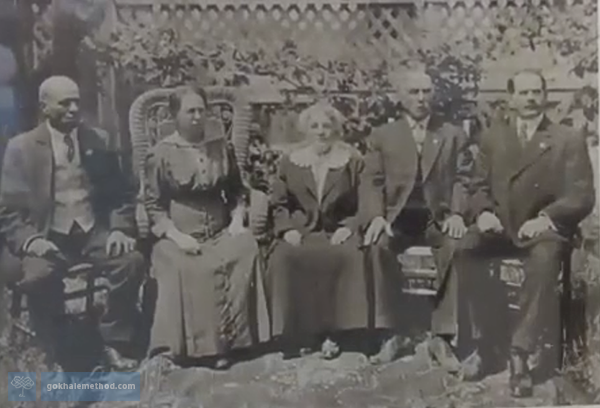
Healthy, open posture, as shown here, was typical in Western societies until the late 19th and early 20th centuries. (Print donated by the Mendocino County Museum to the Gokhale Method Institute’s collection).
While it is true that some people have a greater genetic predisposition to these distortions, e.g., they may have slack ligaments which easily allow them to occur, these changes generally only manifest when a particular area of the body is subjected to sustained and inappropriate loading. When a person retains or relearns healthy posture, genetic predispositions have little opportunity for expression and for distortions to take hold.
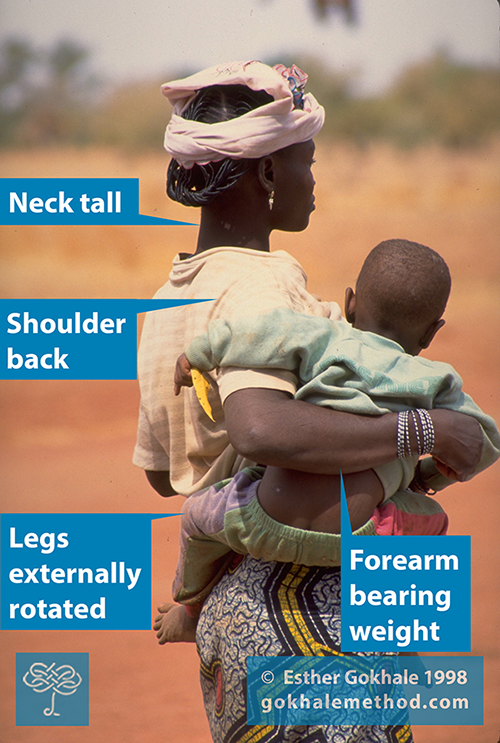
This mother in Burkina Faso positions her head, neck, shoulders, and arms in a way that is harmonious with retaining an upright and mostly flat upper back. Her child is also experiencing healthy posture—his arms and shoulders posterior, his chest open.
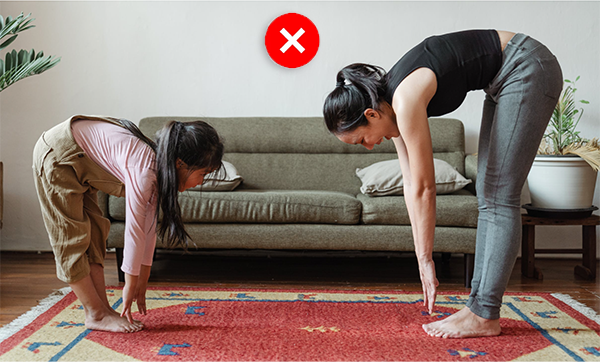
This well-meaning mother is unfortunately encouraging her daughter to round her back as she exercises. Pexels
Why does the upper back hunch?
In some respects, developing a rounded back is not dissimilar from developing bunions—both distortions are the body’s adaptation to a lack of support in the right place, and consequent overloading somewhere else.
Bunions can form when the joint at the base of the big toe repeatedly takes weight that should be in the heel bone. This can be due to wearing a pointed or high-heeled shoe, or simply from habitually standing with weight through the forefoot rather than the heel.
The upper back rounds when it is made to carry and counterbalance the weight of a forward hanging head, neck, shoulders, and arms. In healthy posture the upper body is supported by a more vertical J-shape alignment of the spine and the deep postural muscles, or “inner corset.” This prevents the spine from collapsing into an S-shape, C-shape, or I-shape. You can read more about spine shape here.
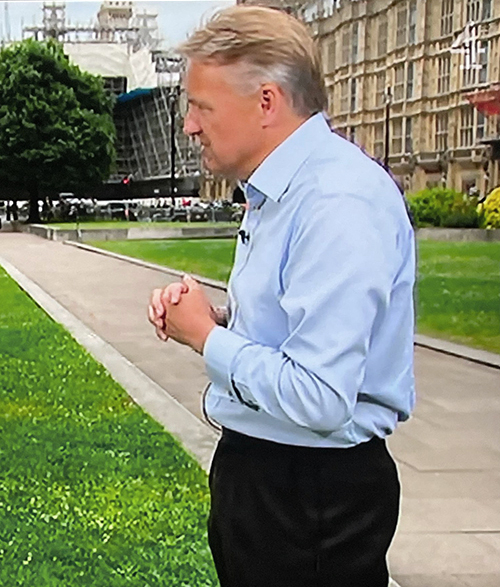
Sir Charles Walker, a British member of Parliament, being interviewed. A tucked pelvis will often result in a rounded upper back and forward head carriage. Channel 4 News (UK)
How to improve rounded, head forward posture
One of the best steps towards finding your J-spine alignment is to realign your head over your body. To develop the deep cervical muscles which counter excessive neck curves, I recommend using the Gokhale™ Head Cushion, which was specifically designed for this therapeutic purpose. It mimics the beneficial effects of head loading, but with a safe amount of weight for people in a society unpracticed in carrying on the head.
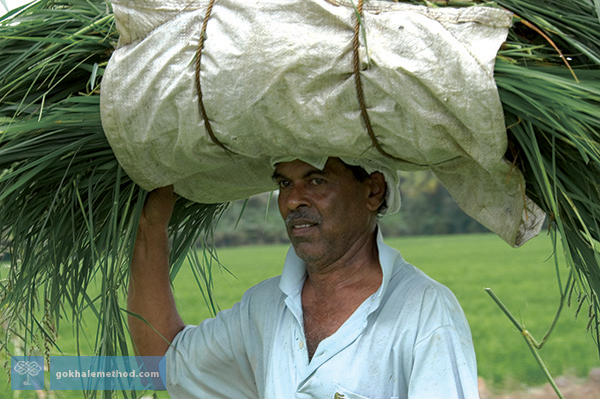
People who carry weight on their head push up against it using their deep neck muscles (longus colli) and inner corset. Their central axis remains tall, with no rounding of the upper spine.
Caution: If you have any neck pain, or suspicion of herniation or other degeneration in the neck, do not do this exercise.
Headloading is a rarely taught but highly effective means of lengthening, strengthening, and aligning the neck, and freeing the upper back.
Upright and open posture is your birthright
By not hunching you can:
- Maintain your full height
- Retain a more youthful appearance
- Avoid muscular pain and tension, especially in the back and neck
- Avoid nerve pain, impingements, and poor circulation in the shoulders and arms
- Encourage the “inner corset” muscles to support and protect the spine
- Avoid compression and degeneration in the spine, including bone, discs, and nerves
- Reduce your risk of osteopenia and osteoporosis in the spine as the bones receive
the healthy stress they are designed for - Enjoy healthier breathing and digestion
Hunching is not an inevitable part of aging
Often people start to notice they are hunching in middle or older age, maybe because it has become more pronounced. Hunching usually starts as a postural habit much earlier in life, yet goes largely unnoticed if there is little stiffness or pain in the area—and it is not yet linked negatively to associations with the aging process. In many traditional cultures people preserve an upright posture well into old age.
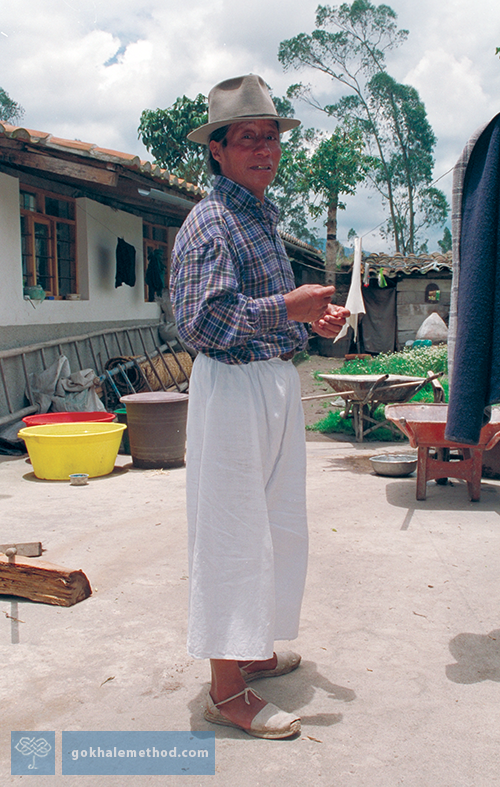
A lifetime of seated work does not make hunching inevitable, as the upright posture of this Ecuadorian backstrap loom weaver shows.
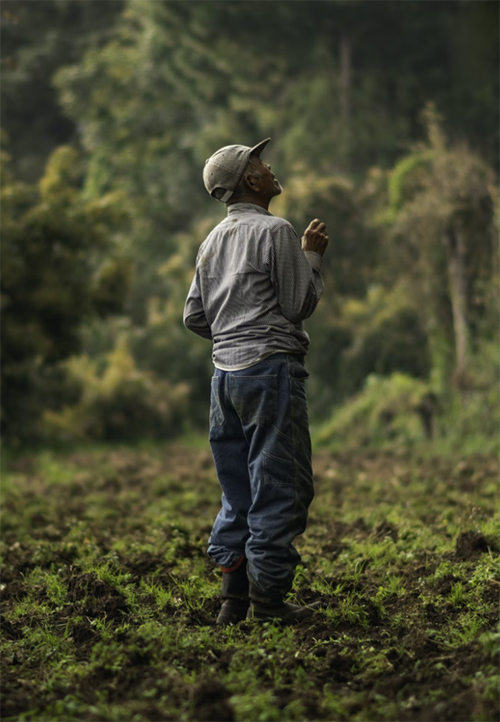
This elderly man in Indonesia has retained posterior shoulders and a wide, relatively flat upper back. Unsplash

This elderly farmer from the Yogyakarta region of Indonesia has preserved an open chest and shoulders that rest back. Unsplash
At whatever age you notice rounding in your back, it is important not to see it as inevitably leading to an extreme kyphosis (severe outward curvature) in the upper spine. Sometimes students come to us in dismay, perhaps shocked to have recently seen themselves so hunched in a particular photograph or video. Rather than despair, use this highly pertinent data as a springboard and incentive to return toward the healthy alignment you had as a young child.
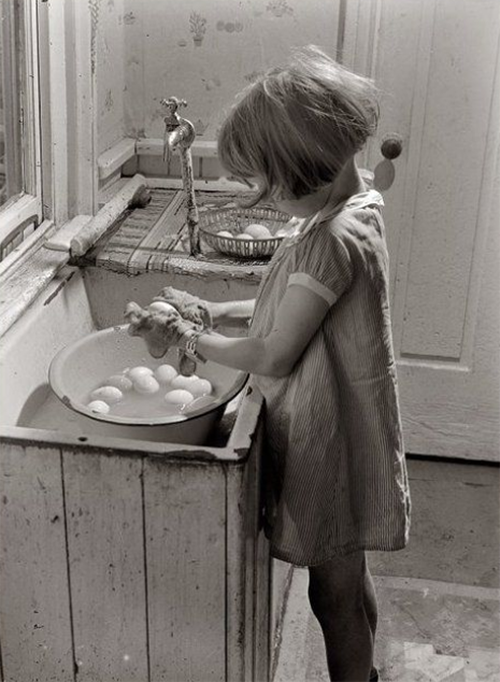
A young girl washes eggs for market near Falls Creek, Pennsylvania, 1940. She inclines slightly forward and lengthens the back of her neck to attend to the task. Her shoulders remain posterior, her chest open—no rounding over! Pinterest
How to mobilize a stiff upper back
In most situations using a suitable roller is my favorite way of mobilizing the upper back. It can ease stiffness in the vertebral joints, soften tight muscles, and improve circulation to the area. To ensure you get all of these up sides and none of the potential downsides from roller work, there are some important guidelines to follow:
- Use a roller that is the right size, density, texture, is non-slip, and robust. The Gokhale™ Roller meets these criteria.
- Rolling needs to be done with a safe technique and healthy postural form, not threaten injury to your back or neck.
- New freedom in the upper back must be balanced with healthy posture to improve muscular tone and alignment. This prevents newly acquired “give” in the area from resulting in further rounding.
Caution: If you have osteopenia or osteoporosis, or suspicion of herniation or other degeneration in your spine, do not do this exercise.
The Gokhale™ Roller has been specifically designed to help you on your posture journey towards a happy, hunch-free back.
How the Gokhale Method resolves hunched posture
Posture education often starts when people analyze their online or in-person Initial Consultation photographs with a teacher. Gokhale Method® teachers have a lot of experience in reassuring people who have a kyphosis (rounded upper back), explaining the mechanisms that got them hunched, and the logical steps they can take to turn this unwanted trajectory around. The Initial Consultation starts the process of students fine tuning their ability to read posture. It can be a revelation.
Initial education in Gokhale Method techniques and the resulting changes can be rapid. Most students soon realize how amenable to change the arrangement of the skeleton and soft tissue can be. Changes to rounded posture are not only possible, but almost guaranteed as students progress through our in-person Foundations or Pop-up course, or online Elements course.
In the case of bony rigidity that has been in place for decades, we work to get improvement around fixed areas, and to prevent it from getting worse. With persistence and patience, a surprising degree of bony changes can take place over time. As with all body tissue, bone constantly renews itself in response to the way it is arranged and used.
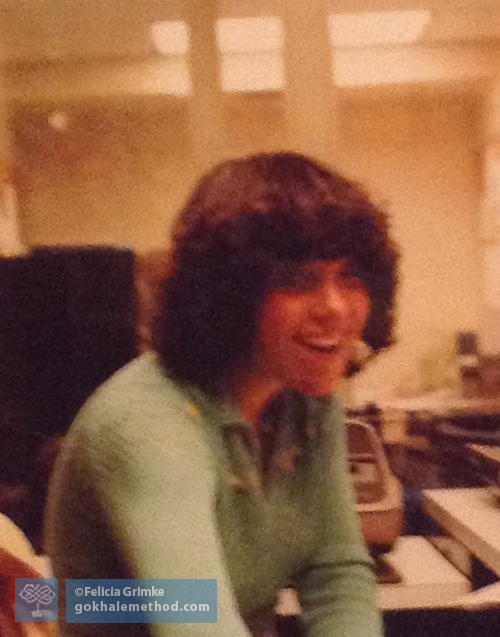
Felicia Grimke, aged 32, was a very hunched and pain-plagued office worker.
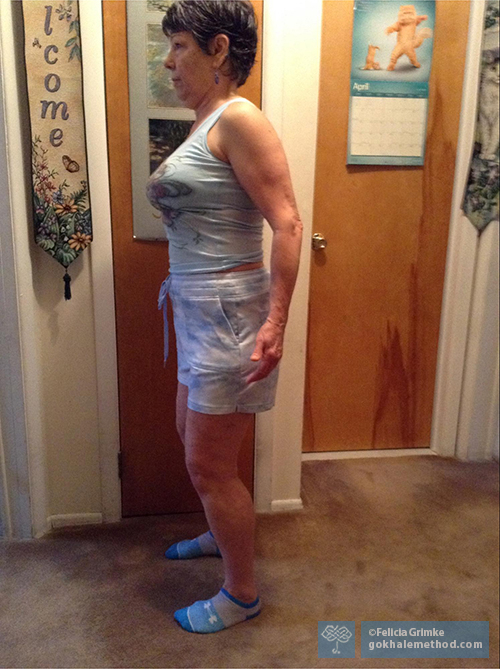
Now a Gokhale Method alumna, Felicia continues to enjoy working on healthy posture and is virtually pain-free for the first time in many decades.
Many of our students have generously shared the story of their journey out of hunching and pain. Do be inspired by Felicia Grimke’s recent post on overcoming hunching, How the Gokhale Method Solved my Neck Pain and Transformed my Life, and sign up for one of our free online workshops below.

Comments
Thank you for this
Thank you for this informative article. I did have a question about this paragraph : "One of the best steps towards finding your J-spine alignment is to realign your head over your body." What about people for whom it is not possible to position their head over their shoulders ? In the beginning of reprogramming posture, anchoring the rib cage reveals one's hunch, especially for people who have a neck hump and a really shortened neck. Creating length in the back of neck of moving the head backwards while anchoring the ribs seems impossible. How should we proceed then ?
You are right, it might not
You are right, it might not be possible in some people, at least not instantly. But even if you just got your neck a little more vertical, a little bit straight, and took the head a little further back, you still start to change for the better.
You would strengthen key muscles, stretch others, and reduce the compression forces going into the neck and upper back.
Eric Fernandez, Gokhale Method Teacher
Thank you Eric ! Esther
Thank you Eric ! Esther mentionned that bringing the head to its natural position works the neck muscles but also muscles in the upper back, as the neck starts in the upper back. Does this mean that bringing the head back and up is supposed to straighten the back a little ? I can do the shoulder roll without it affecting my rib anchor, but bringing the head back and up seems to lift my chest ever so slightly, even while strongly engaging the internal obliques. Is this normal, or should I work more on it ?
Can I use your head cushion
Can I use your head cushion when sitting?
Add New Comment
Login to add commment
Login